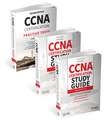Google Cloud Certified Associate Cloud Engineer Study Guide, 2nd edition: Sybex Study Guide
Autor D Sullivanen Limba Engleză Paperback – 8 mar 2023
Din seria Sybex Study Guide
- 20%
 Preț: 204.34 lei
Preț: 204.34 lei - 20%
 Preț: 204.48 lei
Preț: 204.48 lei -
 Preț: 416.00 lei
Preț: 416.00 lei - 20%
 Preț: 204.15 lei
Preț: 204.15 lei -
 Preț: 260.97 lei
Preț: 260.97 lei - 20%
 Preț: 272.31 lei
Preț: 272.31 lei - 20%
 Preț: 467.73 lei
Preț: 467.73 lei - 20%
 Preț: 343.55 lei
Preț: 343.55 lei - 20%
 Preț: 205.15 lei
Preț: 205.15 lei - 20%
 Preț: 289.38 lei
Preț: 289.38 lei - 20%
 Preț: 272.52 lei
Preț: 272.52 lei -
 Preț: 322.04 lei
Preț: 322.04 lei - 20%
 Preț: 304.02 lei
Preț: 304.02 lei -
 Preț: 351.32 lei
Preț: 351.32 lei -
 Preț: 404.31 lei
Preț: 404.31 lei - 20%
 Preț: 175.26 lei
Preț: 175.26 lei -
 Preț: 325.22 lei
Preț: 325.22 lei -
 Preț: 288.65 lei
Preț: 288.65 lei -
 Preț: 383.42 lei
Preț: 383.42 lei - 20%
 Preț: 399.67 lei
Preț: 399.67 lei - 8%
 Preț: 439.48 lei
Preț: 439.48 lei -
 Preț: 427.33 lei
Preț: 427.33 lei - 8%
 Preț: 365.36 lei
Preț: 365.36 lei - 8%
 Preț: 441.16 lei
Preț: 441.16 lei - 20%
 Preț: 274.58 lei
Preț: 274.58 lei -
 Preț: 322.04 lei
Preț: 322.04 lei -
 Preț: 410.24 lei
Preț: 410.24 lei - 20%
 Preț: 298.45 lei
Preț: 298.45 lei - 20%
 Preț: 274.41 lei
Preț: 274.41 lei -
 Preț: 257.89 lei
Preț: 257.89 lei - 20%
 Preț: 289.17 lei
Preț: 289.17 lei - 20%
 Preț: 309.98 lei
Preț: 309.98 lei - 20%
 Preț: 221.89 lei
Preț: 221.89 lei - 20%
 Preț: 411.29 lei
Preț: 411.29 lei - 20%
 Preț: 276.82 lei
Preț: 276.82 lei - 20%
 Preț: 278.23 lei
Preț: 278.23 lei -
 Preț: 326.42 lei
Preț: 326.42 lei - 20%
 Preț: 224.76 lei
Preț: 224.76 lei -
 Preț: 291.72 lei
Preț: 291.72 lei -
 Preț: 321.94 lei
Preț: 321.94 lei - 20%
 Preț: 281.57 lei
Preț: 281.57 lei - 20%
 Preț: 251.37 lei
Preț: 251.37 lei -
 Preț: 324.94 lei
Preț: 324.94 lei - 20%
 Preț: 308.58 lei
Preț: 308.58 lei -
 Preț: 432.32 lei
Preț: 432.32 lei -
 Preț: 407.96 lei
Preț: 407.96 lei - 20%
 Preț: 286.59 lei
Preț: 286.59 lei -
 Preț: 340.54 lei
Preț: 340.54 lei - 20%
 Preț: 280.68 lei
Preț: 280.68 lei
Preț: 294.97 lei
Nou
Puncte Express: 442
Preț estimativ în valută:
56.44€ • 59.20$ • 46.99£
56.44€ • 59.20$ • 46.99£
Carte disponibilă
Livrare economică 11-25 martie
Livrare express 25 februarie-01 martie pentru 62.11 lei
Preluare comenzi: 021 569.72.76
Specificații
ISBN-13: 9781119871446
ISBN-10: 1119871441
Pagini: 600
Dimensiuni: 189 x 233 x 31 mm
Greutate: 1.07 kg
Ediția:2nd Edition
Editura: Sybex
Seria Sybex Study Guide
Locul publicării:Hoboken, United States
ISBN-10: 1119871441
Pagini: 600
Dimensiuni: 189 x 233 x 31 mm
Greutate: 1.07 kg
Ediția:2nd Edition
Editura: Sybex
Seria Sybex Study Guide
Locul publicării:Hoboken, United States
Descriere scurtă
Notă biografică
ABOUT THE AUTHOR DAN SULLIVAN is a data architect specializing in data architecture, data analytics, and machine learning. Dan has also written the official Google Cloud study guides for the Professional Architect and Professional Data Engineer certification exams. He has taught courses on machine learning, data science, and cloud computing for LinkedIn Learning and Udemy, and holds a PhD in genetics, bioinformatics, and computational biology with a focus on infectious disease genomics.
Cuprins
Introduction xxi
Assessment Test xxxiii
Chapter 1 Overview of Google Cloud 1
Types of Cloud Services 2
Compute Resources 3
Storage 4
Networking 7
Specialized Services 8
Cloud Computing vs. Data Center Computing 8
Rent Instead of Own Resources 8
Pay- as- You- Go- for- What- You- Use Model 9
Elastic Resource Allocation 9
Specialized Services 10
Summary 10
Exam Essentials 10
Review Questions 12
Chapter 2 Google Cloud Computing Services 17
Computing Components of Google Cloud 18
Computing Resources 19
Storage Components of Google Cloud 23
Storage Resources 23
Databases 26
Networking Components of Google Cloud 28
Networking Services 28
Identity Management and Security 30
Development Tools 30
Additional Components of Google Cloud 31
Management and Observability Tools 31
Specialized Services 32
Summary 33
Exam Essentials 33
Review Questions 36
Chapter 3 Projects, Service Accounts, and Billing 41
How Google Cloud Organizes Projects and Accounts 42
Google Cloud Resource Hierarchy 42
Organization Policies 45
Managing Projects 46
Roles and Identities 49
Roles in Google Cloud 50
Granting Roles to Identities 50
Service Accounts 52
Billing 53
Billing Accounts 53
Billing Budgets and Alerts 56
Exporting Billing Data 57
Enabling APIs 59
Summary 60
Exam Essentials 61
Review Questions 62
Chapter 4 Introduction to Computing in Google Cloud 67
Compute Engine 68
Virtual Machine Images 68
Virtual Machines Are Contained in Projects 77
Virtual Machines Run in a Zone and Region 78
Users Need Privileges to Create Virtual Machines 79
Preemptible Virtual Machines 80
Custom Machine Types 81
Use Cases for Compute Engine Virtual Machines 82
App Engine 83
Structure of an App Engine Application 84
App Engine Standard and Flexible Environments 85
Use Cases for App Engine 86
Kubernetes Engine 87
Kubernetes Functionality 88
Kubernetes Cluster Architecture 88
Kubernetes Engine Use Cases 89
Anthos 90
Cloud Run 90
Cloud Run Use Cases 91
Cloud Functions 91
Cloud Functions Execution Environment 91
Cloud Functions Use Cases 93
Summary 93
Exam Essentials 95
Review Questions 96
Chapter 5 Computing with Compute Engine Virtual Machines 101
Creating and Configuring Virtual Machines with the Console 102
Main Virtual Machine Configuration Details 104
Advanced Configuration Details 109
Creating and Configuring Virtual Machines with Cloud SDK 117
Installing Cloud SDK 117
Example Installation on Ubuntu Linux 118
Creating a Virtual Machine with Cloud SDK 119
Creating a Virtual Machine with Cloud Shell 120
Basic Virtual Machine Management 121
Starting and Stopping Instances 121
Network Access to Virtual Machines 121
Monitoring a Virtual Machine 123
Cost of Virtual Machines 123
Guidelines for Planning, Deploying, and Managing Virtual Machines 125
Summary 125
Exam Essentials 126
Review Questions 127
Chapter 6 Managing Virtual Machines 131
Managing Single Virtual Machine Instances 132
Managing Single Virtual Machine Instances in the Console 132
Managing a Single Virtual Machine Instance with Cloud Shell and the Command Line 141
Introduction to Instance Groups 147
Creating and Removing Instance Groups and Templates 147
Instance Groups Load Balancing and Autoscaling 149
Guidelines for Managing Virtual Machines 150
Summary 150
Exam Essentials 151
Review Questions 152
Chapter 7 Computing with Kubernetes 157
Introduction to Kubernetes Engine 158
Kubernetes Cluster Architecture 159
Kubernetes Objects 159
Deploying Kubernetes Clusters 162
Deploying Kubernetes Clusters Using Cloud Console 162
Deploying Kubernetes Clusters Using Cloud Shell and Cloud SDK 167
Deploying Application Pods 168
Monitoring Kubernetes 172
Summary 172
Exam Essentials 173
Review Questions 174
Chapter 8 Managing Standard Mode Kubernetes Clusters 179
Viewing the Status of a Kubernetes Cluster 180
Viewing the Status of Kubernetes Clusters Using Cloud Console 180
Pinning Services to the Top of the Navigation Menu 182
Viewing the Status of Kubernetes Clusters Using Cloud SDK and Cloud Shell 188
Adding, Modifying, and Removing Nodes 193
Adding, Modifying, and Removing Nodes with Cloud Console 193
Adding, Modifying, and Removing Nodes with Cloud SDK and Cloud Shell 195
Adding, Modifying, and Removing Pods 196
Adding, Modifying, and Removing Pods with Cloud Console 196
Adding, Modifying, and Removing Pods with Cloud SDK and Cloud Shell 200
Adding, Modifying, and Removing Services 203
Adding, Modifying, and Removing Services with Cloud Console 203
Adding, Modifying, and Removing Services with Cloud SDK and Cloud Shell 205
Creating Repositories in the Artifact Registry 207
Viewing the Image Repository and Image Details with Cloud Console 207
Summary 209
Exam Essentials 209
Review Questions 210
Chapter 9 Computing with Cloud Run and App Engine 215
Overview of Cloud Run 216
Cloud Run Services 216
Cloud Run Jobs 217
Creating a Cloud Run Service 218
Creating a Cloud Run Job 222
App Engine Components 223
Deploying an App Engine Application 226
Deploying an App Using Cloud Shell and SDK 226
Scaling App Engine Applications 228
Splitting Traffic Between App Engine Versions 229
Summary 230
Exam Essentials 231
Review Questions 232
Chapter 10 Computing with Cloud Functions 237
Introduction to Cloud Functions 238
Events, Triggers, and Functions 238
Runtime Environments 239
Cloud Functions Receiving Events from Cloud Storage 241
Deploying a Cloud Function for Cloud Storage Events Using Cloud Console 241
Deploying a Cloud Function for Cloud Storage Events Using gcloud Commands 244
Cloud Functions Receiving Events from Pub/Sub 245
Deploying a Cloud Function for Cloud Pub/Sub Events Using Cloud Console 245
Deploying a Cloud Function for Cloud Pub/Sub Events Using gcloud Commands 246
Summary 247
Exam Essentials 247
Review Questions 249
Chapter 11 Planning Storage in the Cloud 253
Types of Storage Systems 254
Cache 255
Persistent Storage 257
Object Storage 258
Storage Types When Planning a Storage Solution 264
Storage Data Models 265
Object: Cloud Storage 266
Relational: Cloud SQL and Cloud Spanner 266
Analytical: BigQuery 268
NoSQL: Cloud Firestore and Bigtable 270
Choosing a Storage Solution: Guidelines to Consider 277
Summary 278
Exam Essentials 278
Review Questions 280
Chapter 12 Deploying Storage in Google Cloud 285
Deploying and Managing Cloud SQL 286
Creating and Connecting to a MySQL Instance 286
Creating a Database, Loading Data, and Querying Data 288
Backing Up MySQL in Cloud SQL 289
Deploying and Managing Firestore 292
Adding Data to a Firestore Database 292
Backing Up Firestore 294
Deploying and Managing BigQuery 294
Estimating the Cost of Queries in BigQuery 294
Viewing Jobs in BigQuery 296
Deploying and Managing Cloud Spanner 297
Deploying and Managing Cloud Pub/Sub 302
Deploying and Managing Cloud Bigtable 306
Deploying and Managing Cloud Dataproc 308
Managing Cloud Storage 314
Summary 316
Exam Essentials 316
Review Questions 317
Chapter 13 Loading Data into Storage 321
Loading and Moving Data to Cloud Storage 322
Loading and Moving Data to Cloud Storage Using the Console 322
Loading and Moving Data to Cloud Storage Using the Command Line 327
Importing and Exporting Data 328
Importing and Exporting Data: Cloud SQL 328
Importing and Exporting Data: Cloud Firestore 332
Importing and Exporting Data: BigQuery 332
Importing and Exporting Data: Cloud Spanner 337
Exporting Data from Cloud Bigtable 339
Importing and Exporting Data: Cloud Dataproc 340
Streaming Data to Cloud Pub/Sub 341
Summary 342
Exam Essentials 342
Review Questions 344
Chapter 14 Networking in the Cloud: Virtual Private Clouds and Virtual Private Networks 349
Creating a Virtual Private Cloud with Subnets 350
Creating a Virtual Private Cloud with Cloud Console 350
Creating a Virtual Private Cloud with gcloud 354
Creating a Shared Virtual Private Cloud Using gcloud 355
Deploying Compute Engine with a Custom Network 357
Creating Firewall Rules for a Virtual Private Cloud 359
Structure of Firewall Rules 360
Creating Firewall Rules Using Cloud Console 361
Creating Firewall Rules Using gcloud 364
Creating a Virtual Private Network 364
Creating a Virtual Private Network Using Cloud Console 364
Creating a Virtual Private Network Using gcloud 368
Summary 368
Exam Essentials 369
Review Questions 370
Chapter 15 Networking in the Cloud: DNS, Load Balancing, Google Private Access, and IP Addressing 375
Configuring Cloud DNS 376
Creating DNS Managed Zones Using Cloud Console 376
Creating DNS Managed Zones Using gcloud 381
Configuring Load Balancers 382
Types of Load Balancers 382
Configuring Load Balancers Using Cloud Console 383
Configuring Load Balancers Using gcloud 386
Google Private Access 389
Managing IP Addresses 389
Expanding CIDR Blocks 390
Reserving IP Addresses 390
Summary 391
Exam Essentials 392
Review Questions 394
Chapter 16 Deploying Applications with Cloud Marketplace and Cloud Foundation Toolkit 399
Deploying a Solution Using Cloud Marketplace 400
Browsing Cloud Marketplace and Viewing Solutions 400
Deploying Cloud Marketplace Solutions 403
Building Infrastructure Using the Cloud Foundation Toolkit 411
Deployment Manager Configuration Files 411
Deployment Manager Template Files 414
Launching a Deployment Manager Template 414
Cloud Foundation Toolkit 415
Config Connector 418
Summary 418
Exam Essentials 418
Review Questions 420
Chapter 17 Configuring Access and Security 425
Managing Identity and Access Management 426
Viewing Account IAM Assignments 426
Assigning IAM Roles to Accounts and Groups 428
Defining Custom IAM Roles 432
Managing Service Accounts 436
Managing Service Accounts with Scopes 436
Assigning a Service Account to a VM Instance 438
Viewing Audit Logs 440
Summary 441
Exam Essentials 441
Review Questions 443
Chapter 18 Monitoring, Logging, and Cost Estimating 447
Cloud Monitoring 448
Creating Dashboards 449
Using Metric Explorer 450
Creating Alerts 454
Cloud Logging 458
Log Routers and Log Sinks 458
Configuring Log Sinks 459
Viewing and Filtering Logs 459
Viewing Message Details 462
Using Cloud Diagnostics 463
Overview of Cloud Trace 463
Viewing Google Cloud Status 464
Using the Pricing Calculator 464
Summary 467
Exam Essentials 468
Review Questions 469
Appendix Answers to Review Questions 473
Chapter 1: Overview of Google Cloud 474
Chapter 2: Google Cloud Computing Services 476
Chapter 3: Projects, Service Accounts, and Billing 478
Chapter 4: Introduction to Computing in Google Cloud 480
Chapter 5: Computing with Compute Engine Virtual Machines 482
Chapter 6: Managing Virtual Machines 485
Chapter 7: Computing with Kubernetes 487
Chapter 8: Managing Standard Mode Kubernetes Clusters 489
Chapter 9: Computing with Cloud Run and App Engine 491
Chapter 10: Computing with Cloud Functions 494
Chapter 11: Planning Storage in the Cloud 496
Chapter 12: Deploying Storage in Google Cloud 498
Chapter 13: Loading Data into Storage 500
Chapter 14: Networking in the Cloud: Virtual Private Clouds and Virtual Private Networks 502
Chapter 15: Networking in the Cloud: DNS, Load Balancing, Google Private Access, and IP Addressing 504
Chapter 16: Deploying Applications with Cloud Marketplace and Cloud Foundation Toolkit 507
Chapter 17: Configuring Access and Security 509
Chapter 18: Monitoring, Logging, and Cost Estimating 511
Index 515

















